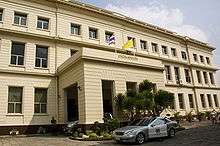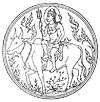Bureau of the Royal Household
|
สำนักพระราชวัง Samnak Phra Ratcha Wang | |
|
'The Seal of Shiva on Nandi's Back' | |
 | |
| Agency overview | |
|---|---|
| Formed | 1895 |
| Preceding agency |
|
| Headquarters | Grand Palace, Phra Nakhon, Bangkok |
| Annual budget | 3.327 billion baht (FY2015)[1] |
| Agency executives |
|
| Website | Palaces.thai.net |
The Bureau of the Royal Household (Thai: สำนักพระราชวัง) is an agency of the Monarchy of Thailand and King Bhumibol Adulyadej. In addition to a range of administrative and ceremonial responsibilities, the bureau also serves as a direct conduit for the King's benevolent philanthropy.[2]
History
 |
| This article is part of a series on the politics and government of Thailand |
|
|
|
|
|
The history of the king's household pre-dates modern Thailand. Links with the past are preserved. For example, the importance of "institutional memory" led to the appointment in the 1980s of a nonagenarian Khun Sawet Thunapradit as "Special Consultant to the Royal Household".[3] In 2009, the Lord Chamberlain of the Bureau of the Royal Household was Keokhwan Vajarodaya.
Palaces
The bureau is responsible for promoting and maintaining three different royal palaces:[4]
Public relations
Some of the public relations of the monarchy are handled by officials of this bureau.[4] For example, during a period in which the king was quite ill, the bureau's official announcements provided information about the monarch's condition.[5]
The BRH, through its Royal Ceremonies Division, is also responsible for organizing events related to the Royal Family of Thailand.
Finances
In 1932, assets of the royal family and household were seized. Much of it was restored after 1947 with the assistance of M.R. Thawiwong Thawalayasak.[6]
The monarchy's household and finances are managed by the Bureau of the Royal Household and the Crown Property Bureau, respectively. They are quasi-government agencies of the Royal Thai Government with nominal cabinet representation on their respective governing boards but with the majority of personnel, in practice, being appointed by the palace.[7]
References
- ↑ Royal Thai Government Gazette, The Annual Expenditure Budget Act for FY2015 Vol. 131 Sec. 69ก 30 September 2014
- ↑ Iamtan, Suparat. "Royal assistance for families of bereaved, injured," The Nation (Bangkok). April 17, 2010.
- ↑ Scigliano, Eric. (2002). Love, War, and Circuses:, p. 102. , p. 102, at Google Books
- 1 2 Bureau of the Royal Household
- ↑ Ministry of Foreign Affairs (Thailand): Announcement of the Bureau of the Royal Household Archived May 31, 2010, at the Wayback Machine., October B.E. 2552 (2009)
- ↑ Handley, Paul. (2006). The King Never Smiles: a Biography of Thailand's Bhumibol Adulyadej, p. 97. , p. 97, at Google Books
- ↑ Thailand, the King
Further reading
- Handley, Paul. (2006). The King Never Smiles: a Biography of Thailand's Bhumibol Adulyadej. New Haven: Yale University Press. ISBN 9780300106824; OCLC 466622191
- Scigliano, Eric. (2002). Love, War, and Circuses: the Age-old Relationship Between Elephants and Humans. Boston : Houghton Mifflin, 2002. ISBN 9780618015832; OCLC 49225866
- Library of Congress Country Studies, Thailand
- CIA World Factbook, Thailand
